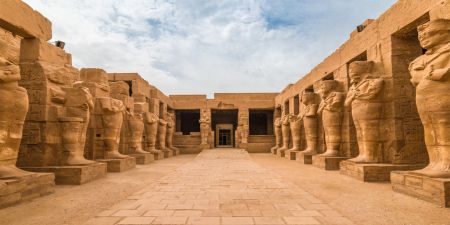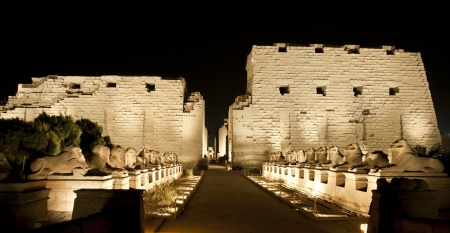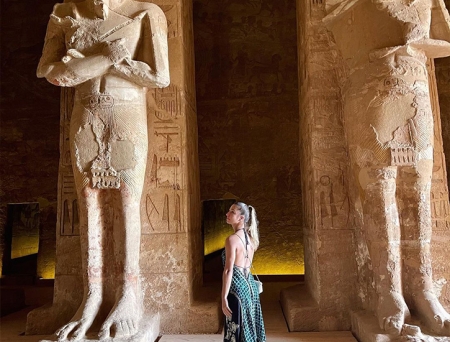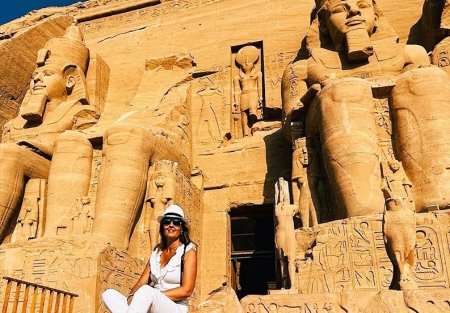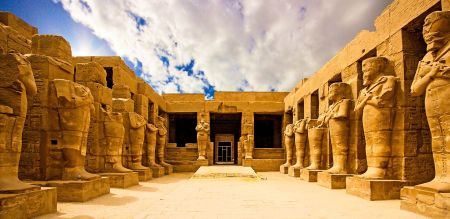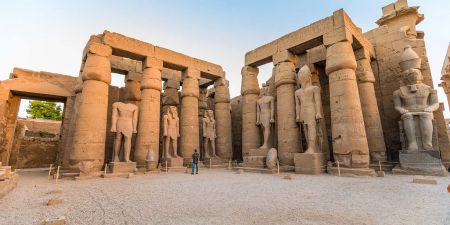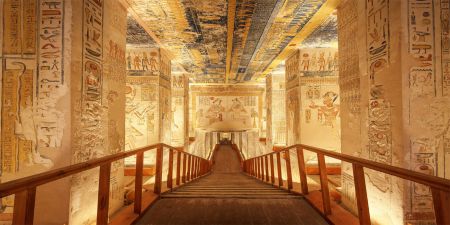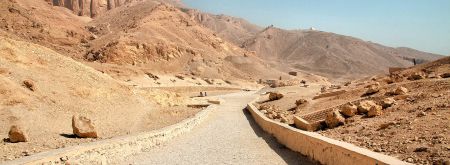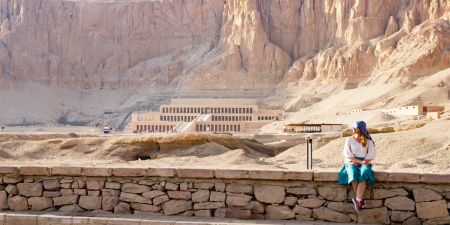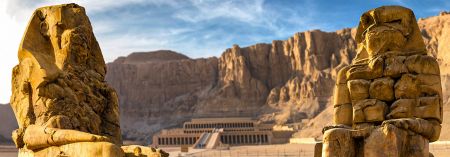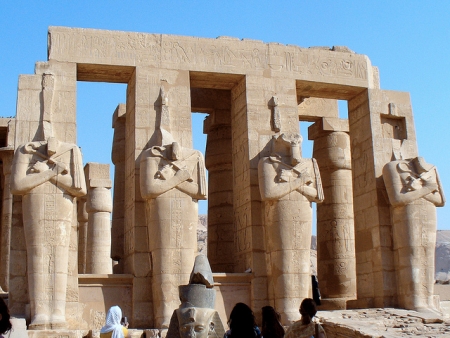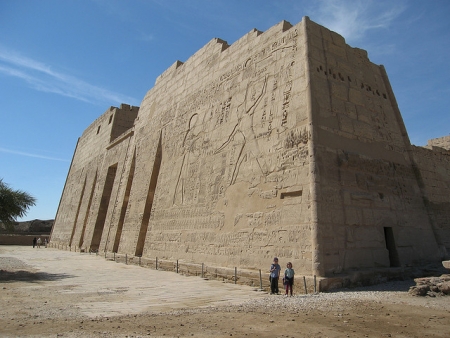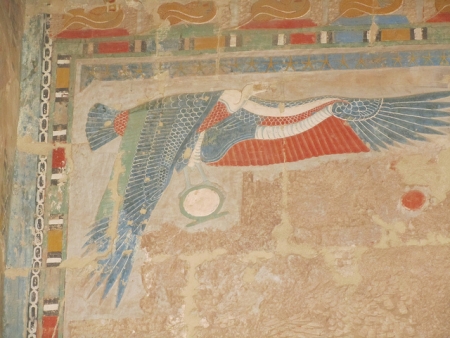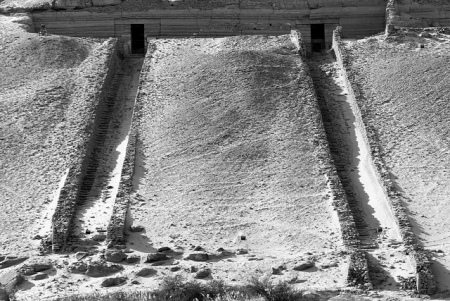Valley of the Queens
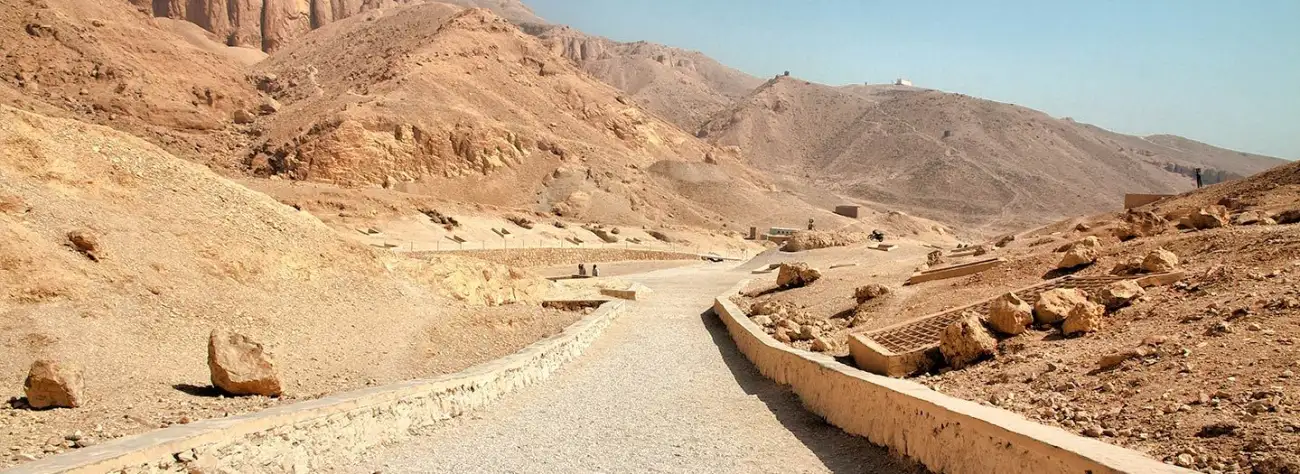
- Where is the Valley of the Queens Located?
- What was the Valley of the Queens Built for?
- Protecting the Royal Treasures for the Afterlife
- When was the Valley of The Queens Built?
- Visiting the Valley of the Queens
- The Tomb of Nefertari
The Valley of the Queens is a major necropolis containing over 110 tombs across its main and subsidiary valleys. Established in the 18th Dynasty, it became the burial ground for royal women and children, beginning with Princess Ahmose’s tomb under Thutmose I. The site flourished in the 19th and 20th dynasties, achieving its height with the creation of Queen Nefertari’s tomb (QV66)—renowned as the “Sistine Chapel of Ancient Egypt” for its extraordinary wall paintings. Recognized as a UNESCO World Heritage Site since 1979, the valley preserves the artistic, architectural, and cultural heritage of ancient Egypt while ongoing conservation work protects its masterpieces for future generations.
The Origins of the Valley of the Queens
The limestone hills on Nile's west bank held deep meaning for Egyptian royalty who wanted eternal rest. This remarkable burial ground became a special place for queens, royal wives, princesses, and some high-ranking nobles during the New Kingdom period. The site saw heavy use through the 19th and 20th dynasties (1292-1075 BCE).
Why it was called Ta-Set-Neferu
Ancient Egyptians gave this sacred necropolis the name Ta-Set-Neferu, which carried two meanings. People translated it as "The Place of Beauty" or "The Place of the Royal Children". This name captured both the location's physical beauty and its role as the final resting place for royal family members.
Queens of earlier times rested within kings' tombs or plain separate chambers. The Ramesside period (1292-1075 BC) changed this practice. Royal women's tombs grew larger and more ornate than their 18th Dynasty ancestors, showing their higher status in Egyptian society.
Geographical location and natural features
The Valley of the Queens is located on Luxor’s West Bank, about 1.5 miles (2.4 km) west of Ramses III’s temple at Madīnat Habu and just south of the Valley of the Kings. Part of the wider Theban Necropolis, it includes several sub-valleys—such as the Valley of Prince Ahmose, the Valley of the Rope, the Valley of the Three Pits, and the Valley of the Dolmen—which together contain 110 tombs. Rugged cliffs encircle the site, forming a natural protective barrier that offered both security and spiritual tranquility. Its position on the west bank aligned with ancient Egyptian beliefs connecting the setting sun with death, rebirth, and the journey to the afterlife.
Connection to Deir el-Medina and Valley of the Kings
Two nearby sites influenced the Valley of the Queens’ selection as a royal burial ground. Deir el-Medina, home to the skilled workers who carved and decorated the tombs, lay only 1 km away, giving craftsmen easy access through the Valley of the Dolmen. The location also balanced the royal necropolis: kings were buried in the north (Valley of the Kings) while queens rested in the south, both within sacred territory. Spiritual considerations further shaped the choice—an ancient Hathor grotto at the valley’s entrance symbolized protection, motherhood, and rebirth, reinforcing the site’s role as a place where royal women could attain divine renewal.
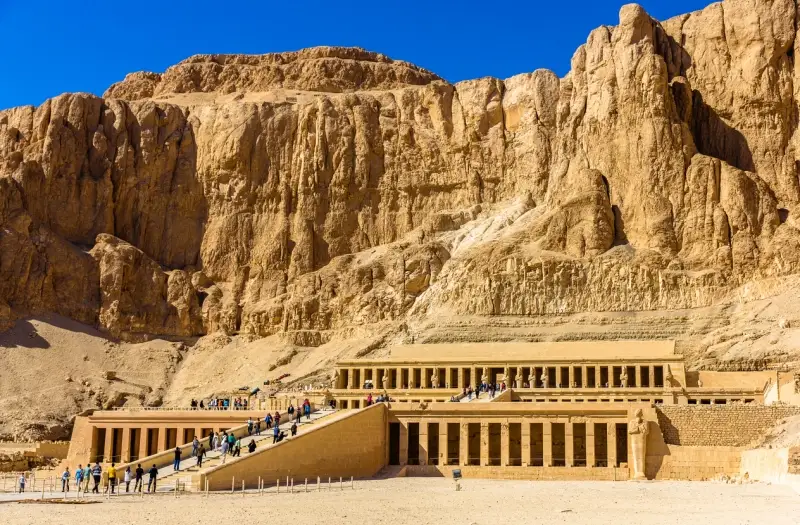
The Valley of the Queens is located on the west bank of the Nile near Luxor, Egypt. It's a significant ancient burial ground that contains over 90 tombs of queens, princesses, and other royal family members from the New Kingdom period, particularly the 19th and 20th dynasties.
Royal Burials Through the Dynasties
The burial practices in the Valley of the Queens changed dramatically across three dynasties of the New Kingdom period. These changes show us how ancient Egyptian society viewed royal women and children differently over time.
Tombs from the 18th Dynasty
The Valley's earliest tombs date back to the 18th Dynasty (circa 1550-1295 BCE). Officials and royal children, rather than queens, were buried here first. Princess Ahmose's tomb was among the first built, likely during Thutmose I's reign. She was the daughter of Seqenenre Tao and Queen Sitdjehuti. Her burial included leather sandals and a linen piece with 20 chapters from the Book of the Dead.
These early tombs had a simple design with a chamber-and-shaft structure. Some tombs expanded to fit multiple burials. Three important shaft tombs from this time exist in the Valley of the Three Pits - QV 89, QV 90, and QV 91. The dynasty's high-ranking queens weren't buried in the Valley. They had large, undecorated tombs filled with beautiful burial gifts from the king in the Western Wadis area.
19th Dynasty and the rise of royal women's tombs
At the start of the 19th Dynasty (c. 1292 BCE), the Valley of the Queens became an exclusive burial ground for royal women, beginning with Queen Sat-Re’s tomb (QV 38), started under Ramesses I and completed by Seti I. During the Ramesside period, queens’ tombs became larger and more elaborate than those of the 18th Dynasty, forming a female counterpart to the Valley of the Kings. Each queen received her own richly decorated rock-cut tomb that reflected her status and role. The most spectacular is Queen Nefertari’s tomb (QV 66), famed for its brilliantly preserved wall paintings depicting her journey through the afterlife.
20th Dynasty: sons and wives of Ramesses III
During the 20th Dynasty (c. 1189–1077 BCE), the Valley of the Queens expanded to include the burial of royal sons as well as queens. Five tombs belong to the sons of Ramesses III, the last great pharaoh of the New Kingdom: Amun-her-khepeshef (QV55), Khaemwaset (QV44), Pareherwenemef (QV42), Ramesses Meryamun (QV53), and Seth-her-khopeshef (QV43), who later became Ramesses VIII. Queen Tyti (QV52), both wife and sister of Ramesses III, was also buried here and may have been the mother of Ramesses IV.
Historical records from this era reveal rising difficulties—workers famously went on strike in Year 29 of Ramesses III’s reign, and tomb robberies increased toward the dynasty’s end, reflecting the growing instability that ultimately contributed to the collapse of the New Kingdom.
Post-New Kingdom reuse and Roman/Coptic periods
The Valley stopped being a royal burial site after the 20th Dynasty. Many tombs found new uses in later eras. People modified tombs to fit multiple burials by digging extra burial pits during the Third Intermediate Period.
The Valley's Ptolemaic Period remains mysterious, but Roman times saw renewed burial activity. The Coptic Period brought fascinating changes until the 7th century CE. Some tombs became Christian spaces. People built hermit shelters, and tombs QV60 (Nebettawy) and QV73 (Henuttawy) show clear signs of Coptic use. They covered ancient wall scenes with plaster and replaced Egyptian images with Christian symbols. The Deir el-Rumi monastery's establishment in the Valley completed its change from royal burial ground to Christian center.
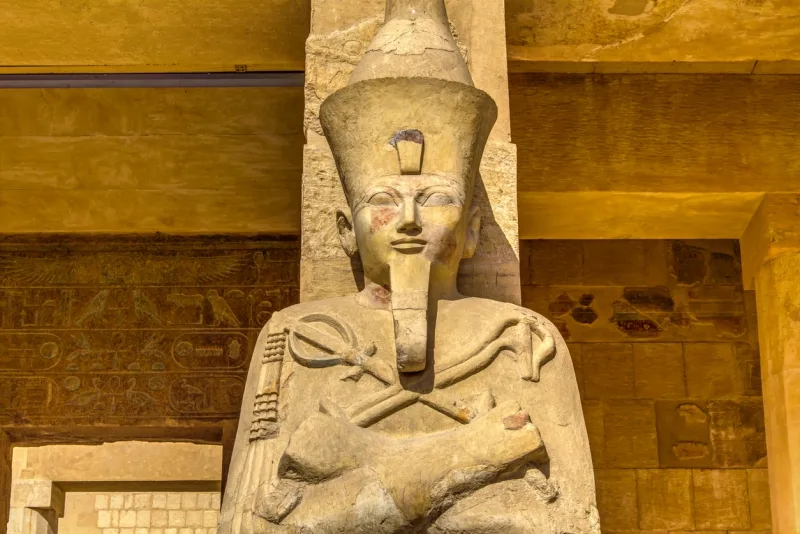
Tombs That Tell Stories
The limestone cliffs of Egypt's Valley of the Queens hide beautifully decorated burial chambers that tell intimate stories of royal lives and ancient beliefs. These tombs showcase vibrant wall paintings and symbolic imagery that give us a rare glimpse into how ancient Egyptian nobility imagined their afterlife.
Queen Nefertari's tomb (QV66)
The magnificent tomb of Queen Nefertari stands out as the most remarkable discovery. Italian archeologist Ernesto Schiaparelli found this masterpiece in 1904. This exquisite burial chamber, known as the "Pearl of Thebes," showcases some of Egypt's best-preserved polychrome reliefs. The walls tell the story of Nefertari's afterlife experience with deities like Isis, Hathor, and Osiris guiding her path.
The tomb's astronomical ceiling makes it truly special. Dark blue paint adorns the surface with golden five-pointed stars scattered across it. The Book of the Dead's Chapters 17, 144, and 146 inspired these decorative elements. Nefertari appears by herself throughout the tomb, without Ramesses II. Her skin bears reddish tones usually meant for male figures, which suggests she took on male attributes to become Osiris in the afterlife.
Prince Amun-her-khepeshef (QV55)
Prince Amun-her-khepeshef's tomb (QV55) reveals a touching story of a life cut short. Ramesses III's eldest son died when he was just 15 years old. Italian archeologists uncovered his tomb in 1903-1904. The vibrant scenes show Ramesses III leading his son to meet the gods of the heavens.
A traditional side lock of hair worn by Egyptian youth helps identify the prince. His sarcophagus still rests in the tomb today. Visitors can connect with this young royal who held impressive titles like "Heir to the Throne," "Royal Scribe," and "Charioteer-in-Chief".
Queen Tyti (QV52)
Queen Tyti's tomb (QV52) tells another captivating story. She played multiple royal roles as Ramesses III's wife and sister, and possibly became mother to Ramesses IV. Her tomb features a Latin cross layout that includes a main corridor, central hall, and side chambers.
The tomb's artwork shows Tyti at different stages of her life. Some scenes portray her as a young girl with braided teenage hair, while others depict her as a middle-aged woman wearing conservative clothes and subtle makeup.
Other notable tombs and their symbolism
The valley contains other fascinating burials beyond these main tombs. Bintanath's tomb (QV71) features beautiful star motifs on the ceiling. Religious imagery shows the queen standing before various deities including Ptah-Sokar, Horus, and Anubis.
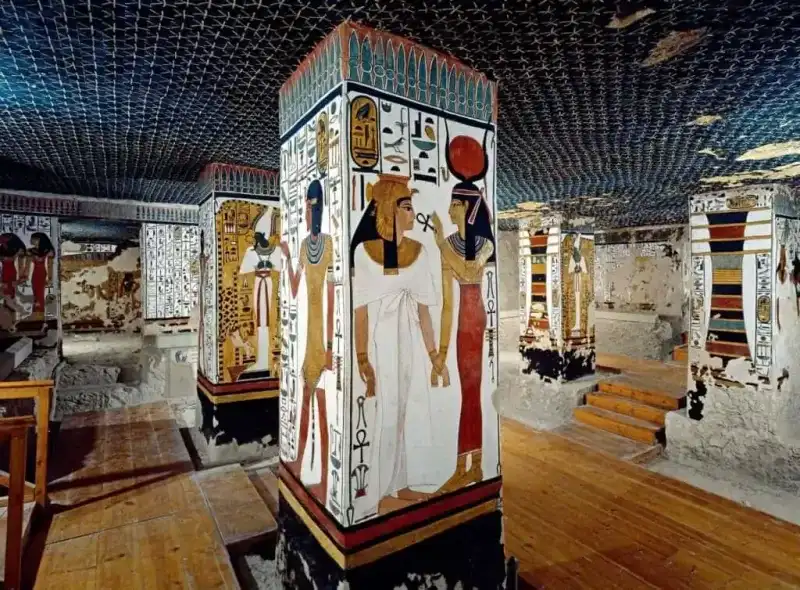
Customize Your Dream Vacation!
Get in touch with our local experts for an unforgettable journey.
Plan Your Trip
Art, Architecture, and Afterlife Beliefs
The Valley of the Queens tombs' artistic and architectural elements teach us about ancient Egyptian views of death and rebirth. These sacred spaces did more than just house the dead. They were vessels that helped royal souls reach eternity.
Tomb layout and structure
Most tombs in the Valley of the Queens share a common design plan. They feature an entrance passage, several short halls, and a sarcophagus chamber. Some grander tombs have two large chambers linked by a corridor and extra side rooms. This design reflects the soul's spiritual trip. Each space plays a specific role in rituals. The physical movement through these private chambers mirrors how the soul moves from life on earth to a divine afterlife.
Use of color and mineral-based paints
These tombs showcase remarkable ancient artistry through their vivid wall paintings. Egyptian artists used mineral pigments from the earth. They ground these into fine powder and mixed them with substances like gum arabic. The eye-catching blue color seen in many tombs wasn't natural. Artists created it by heating a mixture of sand, lime, sodium carbonate, and copper compounds. Each color held special meaning. Black stood for fertility and rebirth, white meant purity, red represented life force. Green symbolized regeneration, while yellow connected to eternal life.
Symbolism from the Book of the Dead
The tomb decorations feature spells and images from the Book of the Dead - a guide for the afterlife journey. These texts helped the dead overcome obstacles and pass divine gatekeepers to reach eternal life. The weighing of the heart ceremony appears often in these tombs. This vital moment shows the deceased declaring their innocence before Osiris and a divine jury.
Depictions of gods and goddesses
Divine figures appear throughout these royal tombs as protectors of the dead. Osiris ruled the underworld, shown with green skin that symbolized resurrection. Queens entering the afterlife received Hathor's welcome - she represented motherhood and fertility. Protective gods like Isis, Nephthys, and the four Sons of Horus stood guard. These divine beings played active roles in transforming the deceased into an akh - a blessed spirit who would live among the gods.
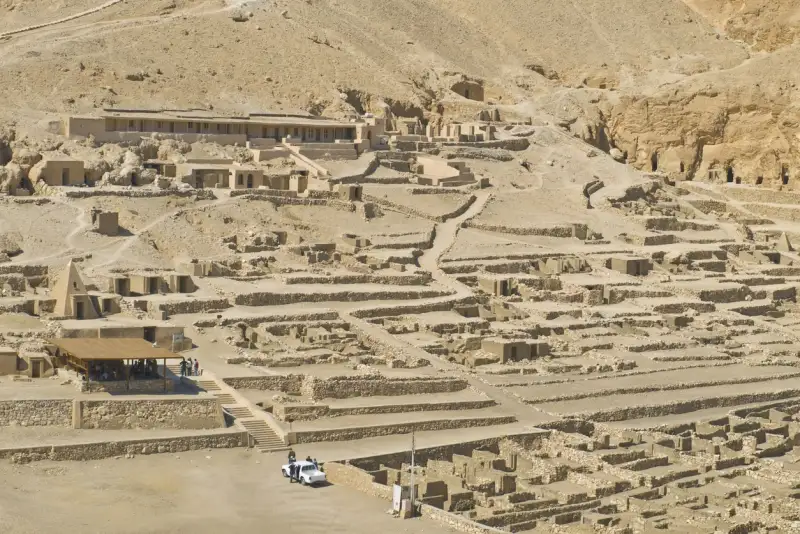
Preservation Challenges and Conservation Efforts
The Valley of the Queens ancient tombs face serious threats from human activities and natural forces. Preservationists must find green solutions to protect these historic sites.
How mass tourism affects the tombs
Tourist crowds created major preservation challenges before the 2011 revolution. Large groups of visitors raised tomb temperatures and humidity levels. Carbon dioxide readings went above 3500 ppm - nowhere near the safe limit of 1500 ppm. Visitors damage the tombs when they touch walls, write graffiti, and hit their heads on low ceilings. Glass barriers now protect many tombs, but they gather dust and make viewing difficult.
Environmental threats like salt and humidity
Flash floods pose the deadliest threat to the Valley and have caused devastating rock collapses through the centuries. The Valley's limestone contains high clay content, which makes problems worse when water seeps in and makes the clay expand. Water also dissolves salts in tomb walls that later recrystallize and shatter stone surfaces. The salt "eats away at the stone like an acid".
Bat colonies and biological damage
Bats have made homes in many open tombs and created serious conservation problems. Their blood stains and droppings damage the wall paintings and inscriptions. While bats help the ecosystem, they can put visitors' health at risk by spreading diseases like histoplasmosis or rabies.
Modern conservation strategies
Current preservation work focuses on controlling visitor numbers, adding air circulation systems, and installing plexiglass barriers. Nefertari's tomb shows strict protection measures - visitors get just 15 minutes inside and need special tickets. Teams now create detailed replicas to reduce wear on the original sites.
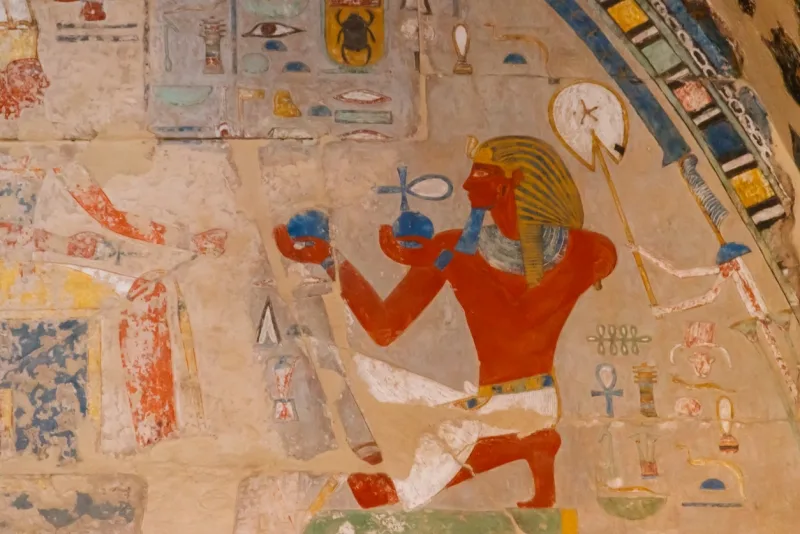
The most renowned tomb in the Valley of the Queens is that of Queen Nefertari (QV66). Often called the "Sistine Chapel of Ancient Egypt," it's celebrated for its breathtaking wall paintings and is considered one of the best-preserved and most beautiful tombs in Egypt.
Initially used for officials and royal children in the 18th Dynasty, the Valley became an exclusive burial site for queens in the 19th Dynasty. By the 20th Dynasty, it also included tombs for royal sons. After the New Kingdom period, many tombs were reused for multiple burials and later repurposed during the Roman and Coptic periods.
The Valley faces several preservation challenges, including damage from mass tourism, environmental threats like flash flooding and salt crystallization, and biological damage from bat colonies. These factors can harm the delicate wall paintings and structures of the tombs.
The tomb decorations, including vibrant wall paintings and symbolic imagery, provide insights into ancient Egyptian afterlife beliefs. They often depict scenes from the Book of the Dead, showing the deceased's journey through the afterlife, and feature various gods and goddesses believed to guide and protect the soul in the next world.


